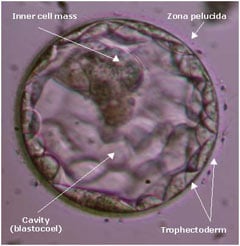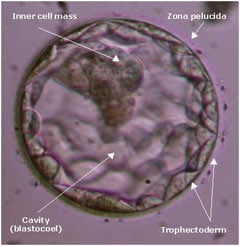
 If you're undergoing or researching IVF, you may have learned that not all embryos are able to implant, and therefore sometimes the decision is made not to transfer an embryo to the patient after an analysis is performed. The analysis used to make that determination is called blastocyst grading. What exactly is the embryology lab looking for when they perform blastocyst grading?
If you're undergoing or researching IVF, you may have learned that not all embryos are able to implant, and therefore sometimes the decision is made not to transfer an embryo to the patient after an analysis is performed. The analysis used to make that determination is called blastocyst grading. What exactly is the embryology lab looking for when they perform blastocyst grading?
First let's define a blastocyst. In the IVF process, after eggs are retrieved by the physician, they go to the embryology lab. There, the eggs are fertilized by the sperm and the fertilized eggs (embryos) are further cultured. The embryos divide over the next few days and have a typical appearance as they progress. Approximately 5 days after retrieval, the embryos reach what is called as the blastocyst stage.
A blastocyst consists of an inner cell mass (which forms the baby), the outer cell mass (or trophectoderm, which forms the placenta) and there is a fluid filled cavity (the blastocoel). There also is an outer covering or "egg shell" (zona pellucida). The appearance or grade of the blastocyst can be used to predict the chance of pregnancy. A blastocyst with a higher grade has a better chance of implanting than one with a lower grade.
The embryologist will typically tell the patient that a blastocyst has received a grade consisting of a number and two letters, for example: 4AA.
The number explains the degree of embryo expansion of the blastocyst cavity and its progress in hatching out of the zona pellucida on a scale from 1-6; as the embryo expands, the degree of expansion increases. The first letter indicates on a scale from A to C (A being the highest) the quality of the inner cell mass, which potentially becomes the cells that form the body of the embryo after implantation.
The second letter is also on a scale from A to C (A being the highest), and this grade indicates the quality of the trophectoderm, the cells that give rise to the placenta and extraembryonic tissues after implantation. Implantation is the process of the human blastocyst attachment to the luminal epithelium of the uterus within six to eight days after fertilization.
A morphologically “perfect” day 5 embryo transfer would be a 4AA; good expansion and excellent inner cell mass and trophectoderm. When a blastocyst scores 5AA on day five the blastocyst is starting to “hatch” with normal appearing inner cell mass and trophectoderm. Therefore when a blastocyst scores a 6AA on day five, the blastocyst is completely “hatched” with nice inner cell mass and trophectoderm.
While morphology is an important factor, do not panic if your blastocyst is not “perfect” quality! Many pregnancies do occur from AB or BB quality embryos; however, embryos with CC quality are considered non-viable and are not transferred.
To see a fertility specialist who is a board-certified physician with excellent success rates, make an appointment at one of InVia’s four Chicago area fertility clinics.

Kelly Schorsch is one of the members of the Embryology team at InVia Fertility. She works in both the Andrology and Embryology sections. She completed her graduate studies at Eastern Virginia Medical School in Clinical Embryology and Andrology and her undergraduate studies at Roosevelt University with a major in Biology, minor in Chemistry, and certificate in Biotechnology. She loves to be behind the scenes in the laboratory to help couples achieve their dreams of one day having a baby.
Subscribe to our weekly blog digest

Entire Website © 2003 - 2020
Karande and Associates d/b/a InVia
Fertility Specialists

Comments